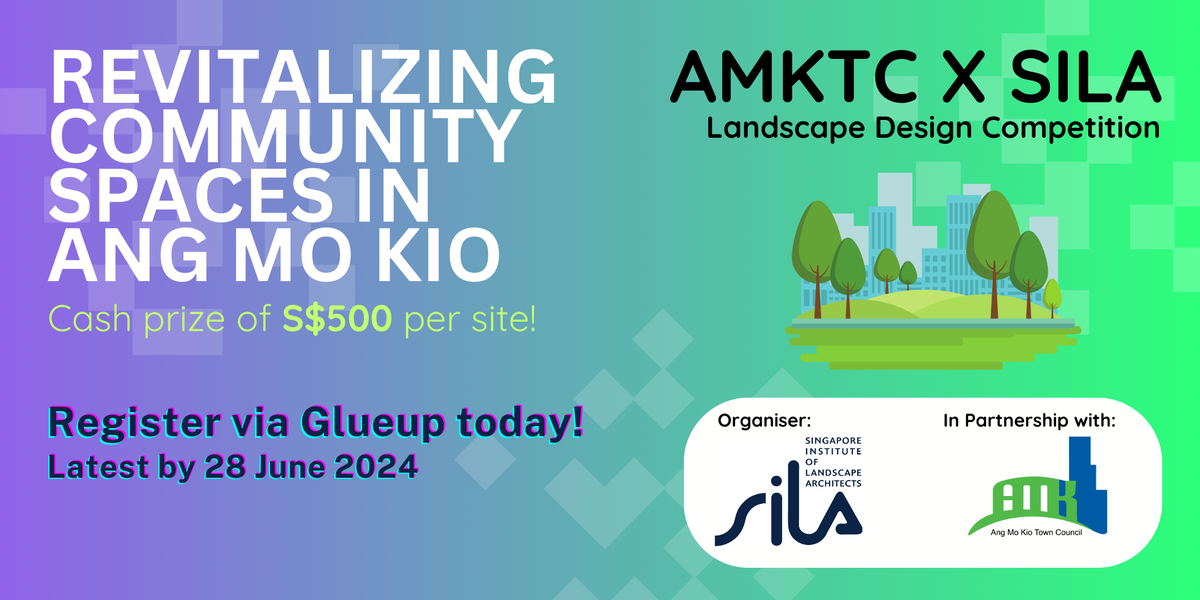Event Details
Revitalizing Community Spaces in Ang Mo Kio
The Ang Mo Kio Town Council (AMKTC) has identified two green pockets in Ang Mo Kio to be revitalized for a young families and senior residents respectively. As part of the estate improvement plans, this iconic heartlands which was first developed in the 1970s now caters to the changing needs its residents. Fast forward to today, the latest addition to Singapore's first walking and cycling town is slated to have tech giant Apple expand its AMK campus[1] , whereby the two green pockets are located 8 to 14 minutes by bicycle. The deployment of cycling network, enhancing green spaces for young families and age-friendly spaces that should support and connect communities for the social sustainability of this town.
Landscape Design Competition
The AMKTC and SILA would like to invite local Institutes of Higher Learning (IHL) to submit creative landscape designs for the two green pockets (refer to map and images) to revitalize these spaces into community space for residents. One selected design will win a prize and obtain a certificate that will be presented on a notable AMKTC event. The winning design will also be implemented on site with a mention of the design competition winners. Participants who are interested in the competition can register their team names by 28 Jun 2024, 11.59pm.
[1] Apple campus expansion: https://www.channelnewsasia.com/singapore/apple-ang-mo-kio-campus-250-million-expand-4274201
Important Milestones
17 June 2024: Launch of the Competition
28 June 2024: Registration and submission of team names
19 July 2024: Interim Concept Review by SILA Mentors
16 August 2024: Submission of final competition entries
23 August 2024: Judging of Entries
3 Nov 2024: Official Announcement and Prize Presentation
*The timeline is indicative and subject to change.
Eligibility
Current students from landscape architecture or landscape design-related institutions are eligible to participate.
Each IHL must submit at least one entry for each green space. Each entry can be submitted by an individual student or a team of students (not more than four members).
Registration and Fee
Registration is to be made online via Glueup. Upon successful registration, the participant will receive a Competition Registration Number at the registered email address. The numbering system will be at random.
Free entry for students.
Tickets
- Free Admittance
- Complimentary
Submission Information
All submissions shall be placed in the link the secretariat provided.
Each submission must contain the following two (2) folders:
o Project binder
o Electronic boards
Project binder
Project shall be submitted in the form of A4 project binder with the following conditions. Entries that do not fulfill these guidelines will not be considered for the competition.
- The project binder allows a maximum of 20 pages. Each page shall be in A4 size.
- All pages shall be in .pdf format.
- Any materials included beyond the 20 pages will not be considered.
- All work should be shrunk to fit A4 size.
- Participants should not submit any material not directly related to the project for judging.
- Materials in the binder must not reveal the names of the participants.
Project binder must contain the following items:
- Executive Summary: To provide 500 words Executive summary in .pdf format. Briefly describe the concept behind the submission.
- Site Plan: Include a simple illustrated site plan to give the jurors context of the entire project with its immediate surroundings.
- Concept drawings: Include no more than eight (8) total schematic, conceptual, artist impressions or sketch drawings illustrating the thought process undertaken to arrive at the final design concept. Brief captions of no more than 40 words each may accompany each drawing. The concept drawings and accompanying caption should be able to convincingly demonstrate the translation from concept drawings to implementation. There should be no more than two (2) drawings on each page view.
- Plant List: Include a list of plants featured in the project.
Electronic boards
Each entry is to submit 2 x A1 (landscape format) softcopy in .png or .jpg format at a resolution of 300dpi. Please submit the filename according to the format "Panel 1_<Reg. No.>", "Panel 2_<Reg. No.>".
A link will be provided for the submission of panels after registration. Each entry to be kept to a maximum of 20MB. All submissions must be received by Friday, 16th August 2024, 1159pm (Singapore date and time).
Note that no names or any form of identification shall be shown on the electronic boards.
Incomplete submission may mean disqualification from the awards.
Competition Guideline
General purpose/ Aim
The designers shall design each site to create;
a) a family-friendly pocket park for residents of all age-groups from the surrounding estates, providing green, playful, relaxing spaces for everyone to enjoy.
b) spaces and programmes to promote social bonding among residents.
c) a unique identity for the neighbourhood.
d) micro habitats to attract wildlife to thrive in a dense urban landscape.
Site Surrounding & Context
The designer is required to study and analyse the site context to gain a better understanding of the site surroundings on the following aspects:
1. Site analysis: The designers shall analyse the surrounding context of the site including, but not limited to;
a) landuse plans
b) existing vehicular, cycling and pedestrian circulation
c) any proposed future development works
d) existing vegetation / habitats
e) potential user-catchment area
f) any site constraints or opportunities, such as drainage patterns, access points, and other factors that can influence the functionality of the design.
2. Cultural and social relevance: The designers shall research about the cultural and social aspects of the site, including its historical significance (if any), local community needs, and preferences. The aim is to ensure that the design resonates with the people who will use the space.
3. Understanding the users: Students are encouraged to explore innovative ideas to engage with the community and to understand their needs and expectations.
4. Embracing City in Nature and well being approach: Teams are encouraged to integrate nature and well-being components into their design.
Design concept
The designer shall develop a concept drawing from a thorough understanding of the current site, users as well as its cultural and natural history.
The design should be not only aesthetically pleasing but also functional, sustainable, and culturally/socially relevant.
Pocket Park Planning Parameters
1. Limited Hardscape:
- The design proposals must abide by the requirement of hardscape area to be less than 10-20% of the entire site area (for each site).
2. Low-cost interventions:
- The designers shall propose low-cost sustainable interventions without compromising on the quality of innovation, functionality, safety, durability and aesthetical appeal.
3. Access & circulations:
- Proper and convenient access should be provided from the surrounding residential blocks and existing cycling path.
- All pedestrian circulation must meet the requisite universal design standards set by BCA.
- Ramps shall be provided to mitigate any level difference within the park and comply with BCA's standards of barrier free accessibility.
4. User-friendly:
- The students must consider surrounding community's needs.
- The students shall suggest passive and active areas for all age-groups.
- The design of the park shall be naturalistic and create a sense of respite from the surrounding urban area.
- The designers should also suggest strategies to create a unique identity for the neighbourhood.
5. Environmentally sustainable designs:
- Consider the environmental impact of the proposal, including sustainable design practices and eco-friendly materials.
- The students shall also consider the maintainability of the proposed hardscape as well as softscape design elements.
6. Planting Considerations
- Ensure sufficient shade for all activity spaces and pathways with suitable trees with large crowns.
- Special focus shall be given on inclusion of native and edible plant species.
- Trees with poisonous attributes or large fruits should be avoided.
- Designers shall also consider shading the perimeter of the park.
Key Design Considerations:
- Safety: Prioritise safety by ensuring that proposed design elements and surfaces are age-appropriate and compliant with safety standards.
- Inclusive landscape features: Design and incorporate landscape features and activities suitable for different age groups as well as physical abilities.
- Supervision and visibility: Design the layout to allow for easy supervision and ensure good visibility for caregivers.
- Natural elements: Designers shall propose innovative landscape features and activities incorporating natural elements where possible. For example, utilise natural environments that offer open-ended play for children by incorporating elements like sand, logs, twigs, leaves, rocks, and stones, while integrating natural elements such as greenery, natural materials, and sensory experiences to create a stimulating and engaging play environment.
- Maintenance and durability: Select materials and equipment that are durable, easy to maintain, and resistant to wear and tear.
- Shade and comfort: Provide shaded areas and seating for caregivers to ensure comfort and protection from the elements.
- Area zoning: Create distinct zones within the site for different types of experiences such as active zone, imaginative zone, and quiet zone, to cater to diverse interests and activities.
- Circulation and flow: Design pathways and circulation routes that are intuitive and allow for easy movement between play elements while minimizing congestion.
- Engaging aesthetics: Incorporate vibrant colours, playful designs, and thematic elements to create an inviting and visually stimulating environment for the users.
- Sound and sensory experiences: Integrate sensory-rich hardscape as well as softscape elements to improve the wellbeing of the users.
- Be considerate of the surrounding: The designers shall not propose any design elements that may disturb the nearby residents. For example, the glare from the installed lights must not cause disturbance to any residents around the park. The lighting throw direction of the light shall be downward facing unless it is on pole which focuses on the trees.
Technical Requirements
1. Universal Design
The design of the pocket park shall provide access throughout with graded levels and finishes suited for the physically challenged. Refer to BCA Barrier-Free Access code and Universal Design Guidelines for further information and compliance.
2. Materials and Construction Method
All design proposals and implementation details shall consider the construction methods that will be used for implementation. Construction methods proposed shall minimise the impact on the environment.
Proposed materials shall take into consideration of lifecycle costing to reduce maintenance cost downstream. The detailed design should adopt materials and features that are environmentally friendly, and these shall also be cost efficient. These may include recycled materials, energy and water efficient design features and measures that can minimise construction waste.
3. Park Furniture
Proposed landscape elements should be designed in detail considering the ease of construction and maintainability. The benches shall comply with Universal Design standards.
4. Lighting
The students shall propose a functional and interesting lighting scheme to enliven the park during the dark hours. Some attraction nodes shall also have a unique lighting strategy to give the space a distinctive appeal.
5. Compliance to the latest version of the following must be attained:
i. BCA Accessibility Code (Latest)
ii. BCA Universal Design Guide (Latest)
iii. Any other mandatory authority requirements
Prize
Cash Prize: S$500 per site
AMKTC-SILA Landscape Design Competition is organised by AMKTC & SILA, and all rules, jury and winner nomination remain at the sole discretion of AMKTC & SILA.
AMKTC & SILA reserves the right not to award any Award when appropriate.
AMKTC & SILA also reserves the right to change or amend the Rules, to postpone the competition, to interrupt it or to cancel the competition at any time without prior notice and without any compensation to any participant.
Exhibition
After the announcement of the winners, all submission materials may be exhibited at a Public Exhibition in Singapore at a date and venue to be confirmed.
Registration and participation in the AMKTC-SILA Landscape Design Competition acknowledges agreement by the participants for their submission to be exhibited publicly, in connection with the AMKTC-SILA Landscape Design Competition.
Disqualification Criteria
The Organisers reserves the right to disqualify any participant/s if:
- The submission is received after the closing date and time stipulated;
- Any of the terms and conditions of the competition or specific instructions are disregarded;
- The design proposal is found to be not an original work of the participant.


